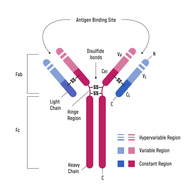IgA Induced Mucosal Immune Tolerance
TECHNOLOGY NUMBER: 2021-134

OVERVIEW
A method for delivering IgA complexed with its antigen to limit allergic responses- Produces a tolerating signal that prevents progression to severe responses
- Can be used to treat ongoing allergic and autoimmune responses
BACKGROUND
Immunoglobulin A (IgA) is the most abundant antibody in humans, comprising the majority of the immunoglobulin in secretions and second only to immunoglobulin G (IgG) in the circulation. IgA is predominately located in high concentrations in mucous secretions including saliva, milk, tears, and secretions from the respiratory tract, gut, genitourinary tract, and prostate. One of the main functions of IgA is to protect mucosa-lined tissues from microbial invasion and to help maintain immune homeostasis with microbiota. The IgA system integrates with other innate and adaptive immune systems to facilitate that balance. The induction of mucosal immune responses can occur throughout life, but the regulation of these responses is critical to avoid severe inflammation and unwanted immune responses that lead to disease. A need exists to foster methods for prevention of IgA-mediated allergic reactions.
INNOVATION
Researchers at the University of Michigan report that IgA complexed with its specific antigen can provide a tolerizing signal in animals with an existing allergy response through the generation of regulatory T cells (Tregs) that prevent the progression to chronic and severe responses in the lung and gut blocking asthma-like and food induced anaphylaxis. The investigators propose that development of allergen-specific IgA can be used as a therapy to treat ongoing allergic and autoimmune responses by generating antigen specific Treg cells to control the severity of the ongoing immune responses.